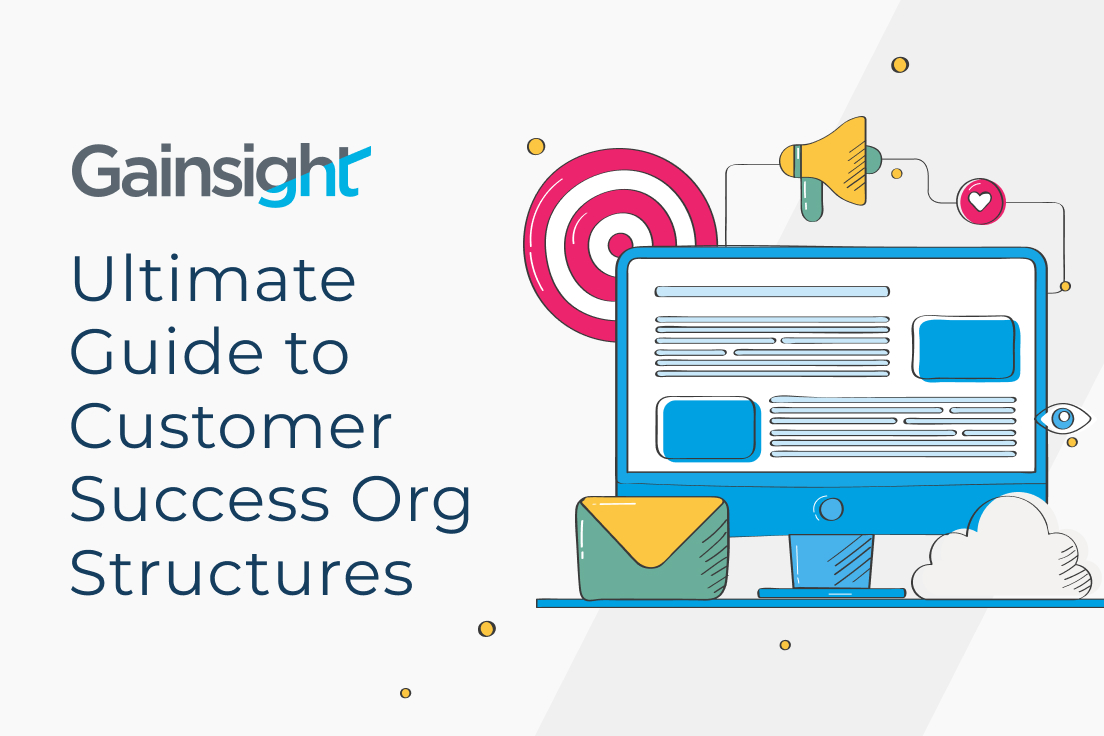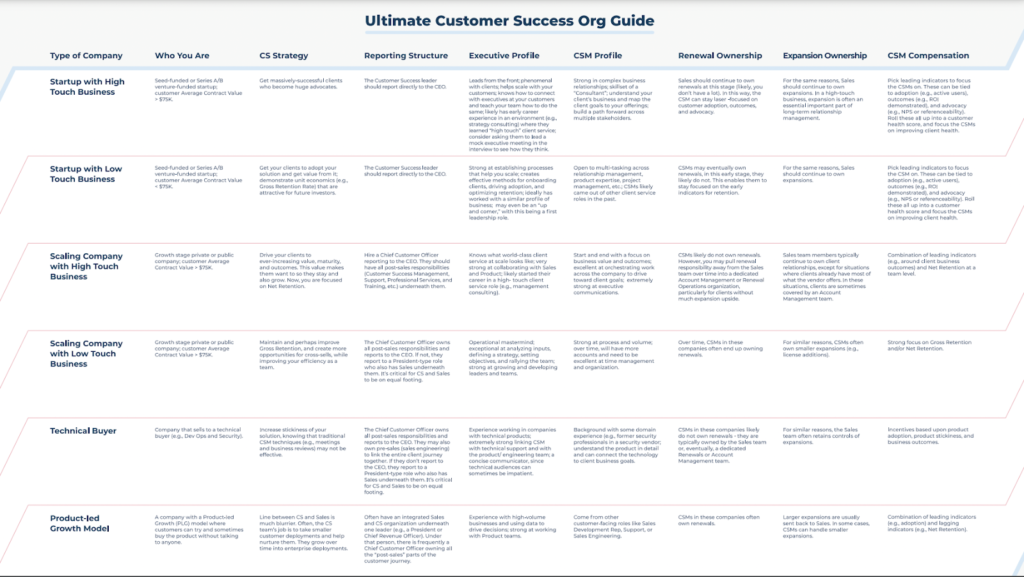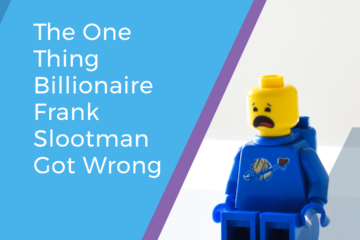

“Do you have time for a quick call? I’d love to get your input on our Customer Success Organization.”
I’ve received at least 500 emails, texts, and Linkedin DMs like this from SaaS CEOs over my nine years running Gainsight. And I LOVE getting these messages. It’s so encouraging to see CEOs leaning into Customer Success.
But to save these leaders time and spread the wealth, I decided to write down my talk track.
Inevitably, CEOs and leaders have the following common questions around how a Customer Success Organization should look:
- What should my Customer Success strategy be?
- Who should Customer Success report to?
- What should I look for in the Customer Success leader?
- What is the profile of the individual CSM?
- Who should own renewals?
- Who should own expansions?
- How should we compensate the CSMs?
So let’s go!

Model 1: Startup with High Touch Business
Who You Are: Seed-funded or Series A/B venture-funded startup; with a customer Average Contract Value > $75K.
Your Customer Success Strategy: Your job right now is to get massively-successful clients who become huge advocates. Nothing is more important than this task.
Your Customer Success Reporting Structure: The Customer Success leader should report directly to you – no question. You need to be very close to your early clients.
Your Customer Success Executive Profile: The CS leader should lead from the front and be phenomenal with your clients. You likely don’t have a big team, so they need to be world-class and help you scale with your customers. They should know how to connect with executives at your customers and teach your team how to do the same. They likely had early career experience in an environment (e.g., strategy consulting) where they learned “high touch” client service. I’d consider asking them to lead a mock executive meeting in the interview to see how they think.
Your CSM Profile: Similarly, CSMs need to be strong in complex business relationships. While they don’t need to have worked in management consulting, the skillset they need is that of a “Consultant.” They need to understand your client’s business, map the client goals to your offerings, and build a path forward across multiple stakeholders.
Renewal Ownership: You likely don’t have too many renewals yet. As such, I’d recommend Sales continuing to own renewals at this stage. In this way, the CSM can stay laser-focused on customer adoption, outcomes, and advocacy.
Expansion Ownership: For the same reasons, Sales should continue to own expansions. Indeed, in a high-touch business, expansion is often an essential part of long-term relationship management.
CSM Compensation: Pick leading indicators to focus the CSM on. These can be tied to adoption (e.g., active users), outcomes (e.g., ROI demonstrated), and advocacy (e.g., NPS or reference ability). You can roll these up into a customer health score and focus the CSMs on improving client health.
Model 2: Startup with Low Touch Business
Who You Are: Seed-funded or Series A/B venture-funded startup; with a customer Average Contract Value < $75K.
Your Customer Success Strategy: You need to get your clients to adopt your solution and get value from it. In parallel, you need to demonstrate unit economics (e.g., Gross Retention Rate) that are attractive for future investors.
Your Customer Success Reporting Structure: There is no question that the Customer Success leader should report directly to you. This reporting structure is too important for them to answer to anyone else.
Your Customer Success Executive Profile: The CS leader should be strong at establishing processes that help you scale. With your likely deal volume, you need to create effective methods for onboarding clients, driving adoption, and optimizing retention. The CS leader has ideally worked with a similar profile of business previously. They may even be an “up and comer,” with this being their first leadership role.
Your CSM Profile: CSMs need to be extremely open to multi-tasking across relationship management, product expertise, project management, and more. CSMs likely came out of other client service roles in the past.
Renewal Ownership: While your CSMs may eventually own renewals, in this early stage, they likely do not. This enables them to stay focused on the early indicators for retention.
Expansion Ownership: For the same reasons, Sales should continue to own expansions.
CSM Compensation: Pick leading indicators to focus the CSM on. These can be tied to adoption (e.g., active users), outcomes (e.g., ROI demonstrated), and advocacy (e.g., NPS or reference ability). You can roll these all up into a customer health score and focus the CSMs on improving client health.
Model 3: Scaling Company with High Touch Business
Who You Are: Growth stage private company or public company; with a customer Average Contract Value > $75K.
Your Customer Success Strategy: You need to drive your clients to ever-increasing value, maturity, and outcomes. This value makes them want to stay and grow. Now, you focus on Net Retention.
Your Customer Success Reporting Structure: You should hire a Chief Customer Officer reporting to you. This person should have all post-sales responsibilities (Customer Success Management, Support, Professional Services, and Training.) underneath them.
Your Customer Success Executive Profile: The CS leader should know what world-class client service at scale looks like. They should be very strong at collaborating with Sales and Product. They likely started their career in a high-touch client service role (e.g., management consulting).
Your CSM Profile: CSMs start and end with a focus on business value and outcomes. They are excellent at orchestrating work across the company to drive toward client goals. They are extremely strong at executive communications.
Renewal Ownership: Your CSM likely does not own renewals.t However, you may pull renewal responsibility away from the Sales team over time into a dedicated Account Management or Renewal Operations organization, particularly for clients without much expansion upside.
Expansion Ownership: Sales team members typically continue to own client relationships, except for where clients already have most of what the vendor offers. In these situations, clients are sometimes covered by an Account Management team.
CSM Compensation: Combination of leading indicators (e.g., around client business outcomes) and Net Retention at a team level.
Model 4: Scaling Company with Low Touch Business
Who You Are: Growth stage private or public company; with a customer Average Contract Value < $75K.
Your Customer Success Strategy: You need to maintain and perhaps improve Gross Retention and create more opportunities for cross-sells, while improving your efficiency as a team.
Your Customer Success Reporting Structure: The Chief Customer Officer owns all post-sales responsibilities and probably reports directly to the CEO. If not, they report to a President-type role who also has Sales underneath them. It’s critical for CS and Sales to be on equal footing.
Your Customer Success Executive Profile: The CS leader is an operational mastermind. They are exceptional at analyzing inputs, defining a strategy, setting objectives, and rallying the team. They are strong at growing and developing leaders and teams.
Your CSM Profile: CSMs need to be strong at process and volume. Over time, CSMs will have more accounts and need to be excellent at time management and organization.
Renewal Ownership: Over time, CSMs in these companies often end up owning renewals.
Expansion Ownership: For similar reasons, CSMs often own smaller expansions (e.g., license additions).
CSM Compensation: Likely strong focus on Gross Retention or Net Retention.
Model 5: Company with a Technical Buyer
Who You Are: Company that sells to a technical buyer (e.g., DevOps and Security).
Your Customer Success Strategy: You need to increase stickiness of your solution, knowing that traditional CSM techniques (e.g., meetings and business reviews) may not be effective.
Your Customer Success Reporting Structure: The Chief Customer Officer owns all post-sales responsibilities and likely reports directly to the CEO. They may also own pre-sales (sales engineering) to link the entire client journey together. If they don’t report to the CEO, they report to a President-type role who also has Sales underneath them. It’s critical for CS and Sales to be on equal footing.
Your Customer Success Executive Profile: The CS leader likely has experience working in companies with technical products. They are extremely strong linking CSM with technical support and with the product/engineering team. They also are likely a concise communicator, since technical audiences can sometimes be impatient!
Your CSM Profile: CSMs likely come from a background with some domain experience (e.g., former security professionals in a security vendor). They understand the product in detail and can connect the technology to client business goals.
Renewal Ownership: CSMs in these companies likely do not own renewals – they are typically owned by the Sales team or, eventually, a dedicated Renewals or Account Management team.
Expansion Ownership: For similar reasons, the Sales team often retains controls of expansions.
CSM Compensation: Incentives based upon product adoption, product stickiness, and business outcomes.
Model 6: Company with a Product-led Growth Model
Who You Are: A company with a Product-led Growth (PLG) model where customers can try and sometimes buy the product without talking to anyone.
Your Customer Success Strategy: The line between CS and Sales is much blurrier in a PLG model. Often, the CS team’s job is to take smaller customer deployments and help nurture them. So, they grow over time into enterprise deployments.
Your Customer Success Reporting Structure: PLG companies often have an integrated Sales and CS organization underneath one leader (e.g., a President or Chief Revenue Officer). Under that person, there is frequently a Chief Customer Officer owning all the “post-sales” parts of the customer journey.
Your Customer Success Executive Profile: The CS leader has experience with high-volume businesses and using data to drive decisions. In addition, they are strong at working with Product teams.
Your CSM Profile: CSMs likely come from other customer-facing roles like Sales Development Rep, Support, or Sales Engineering.
Renewal Ownership: CSMs in these companies often own renewals.
Expansion Ownership: Larger expansions are usually sent back to Sales. In some cases, CSMs can handle smaller expansions.
CSM Compensation: Combination of leading indicators (e.g., adoption) and lagging indicators (e.g., Net Retention).




